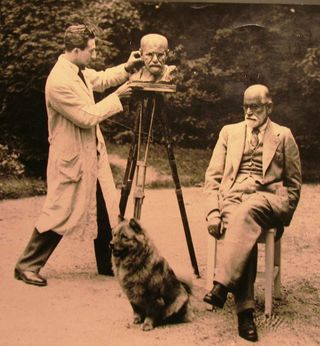Freudian Psychology
Oscar Nemon: Forgotten Sculptor of the Royals, and Freud
Princess Diana, Queen Elizabeth, Churchill, and Freud were all Nemon's subjects
Posted May 19, 2018
When Oscar Nemon died, in 1985, he was working on a relief of Diana, Princess of Wales, for Wedgwood. He had already made two busts of Queen Elizabeth, who called Nemon "the only man who could get Winston Churchill to do as he was told."

Diana was famously kind–she handwrote a long personal sympathy note to Nemon's daughter, Aurelia Young–but that wasn't the case with all of Nemon's well-known subjects. The statue of Sigmund Freud to be unveiled at the Medical University of Vienna on June 4 proves that Nemon managed to charm even the most recalcitrant ones.
An Inauspicious Beginning
Freud did not like sitting for portraits. The results, he claimed, never justified the time he was forced to remain idle. But his devotees wanted to see the great man immortalized in art, the more urgently as Freud aged. In 1931, when Freud was approaching his 75th birthday, Paul Federn, a physician and analyst friend, convinced him to see Nemon, a young Croatian Jewish sculptor.
The match didn’t begin promisingly. Nemon, who had been telegraphed by Federn to rush over from Brussels to Freud’s summer home outside Vienna, initially got a brush off. After Freud reluctantly agreed to let him make a few quick sketches, Nemon’s only pencil broke before he could capture his subject’s beard. And the following morning, when Nemon returned with a clay representation, his taxi made a sharp turn into Freud’s driveway, causing the bust to fall on its nose.

But it turned out to be the start of a beautiful friendship. In a letter to Max Eitingon, another physician and analyst in Freud’s inner circle, Freud wrote, “Federn, who is usually highly inept in discovering unclaimed geniuses, forced him on me. But this time there is something or rather quite a lot in it. The head, which the gaunt, goatee-bearded artist has fashioned from the dirt – like the good Lord – is very good and an astonishingly life-like impression of me.”
And Nemon, who had long admired Freud, became a welcome visitor to his home. He got commissions from many of Freud’s disciples, including Princess Marie Bonaparte, who was instrumental in getting Freud and his family out of Vienna after the 1938 Nazi annexation. Nemon also sculpted Bonaparte’s dog, Topsy, the subject of an eponymous memoir that Sigmund and Anna Freud translated from French into German.
The London Connection
It was at a London party thrown by Freud biographer Ernest Jones that Nemon met his wife-to-be, Patricia Villiers-Stuart; the English debutante and heiress was in analysis with Jones. As their daughter, Aurelia Young, describes the meeting of Nemon and her mother, “He looked straight at her, as was his wont as an artist, listened to her...spoke in French because he couldn't speak English. She fell completely and totally in love with him.” This complicated his life, to say the least: He was already living with another London socialite.
It complicated life for the rebellious Villiers-Stuart, too. Her wealthy parents not only swore to disinherit her, but also tried to get Nemon deported – this, in 1939, when it was becoming increasingly difficult for European Jews to find safe haven from the Nazis. Nemon’s mother, grandmother and several other family members were later killed in Auschwitz.
Nemon managed to stay in London. It didn’t hurt that he had by then sculpted some of the most influential people in the U.S. and Europe, from Charles Lindbergh to the Queen of Belgium. After the war, he got commissions from England’s power elite, including Queen Elizabeth II and Margaret Thatcher. It is considered lucky to rub the foot of Nemon’s monumental statue of Winston Churchill, which resides in the House of Commons.
In spite of these accomplishments, Nemon was never allowed to enter the house of his in-laws.
Back in Vienna
Six months after Freud’s initial sitting with Nemon, the members of the Viennese Psychoanalytic Society were presented with three busts, one in wood, one in stone, and one in bronze. It was left up to Freud to decide which he wanted for a gift.
He wrote to the Society in November 1931:
The choice was not an easy one. Although the busts were made with the same hand and represent the same person, the artist gave each of them an individual charm and distinction not shown by the others and not easily relinquished. Finally, since however, I cannot have three heads like Cerebrus I decided in favor of the one made in wood. With its vivacious and friendly expression, it promises to become a pleasant roommate.
Subsequent pictures of Freud in his study show his wooden doppleganger perched in a shelf behind his desk. The bust traveled with the rest of Freud’s possessions to London when the family fled from Vienna in June 1938. It is now in London’s Freud Museum.

The history of the full-body statue of Freud that Nemon sketched in 1931, the one soon to be unveiled in Vienna, is far more complicated. Suffice it to say for now that a maquette of the statue was slated for Vienna Psychoanalytic Institute in 1936 and that various versions, great and small, were installed in New York, London, and Boston before the sculpture made its way to the city for which it was intended.
Nemon's daughter, Aurelia Young, will be speaking about her father and Freud on June 4 in Vienna and her biography of her father, Finding Nemon: The Extraordinary Life of the Outsider Who Sculpted the Famous, will be published in September.
References
An earlier version of this article, Oscar Nemon: Freud's Forgotten Sculptor, appeared on May 27, 2014, inThe Forward.




